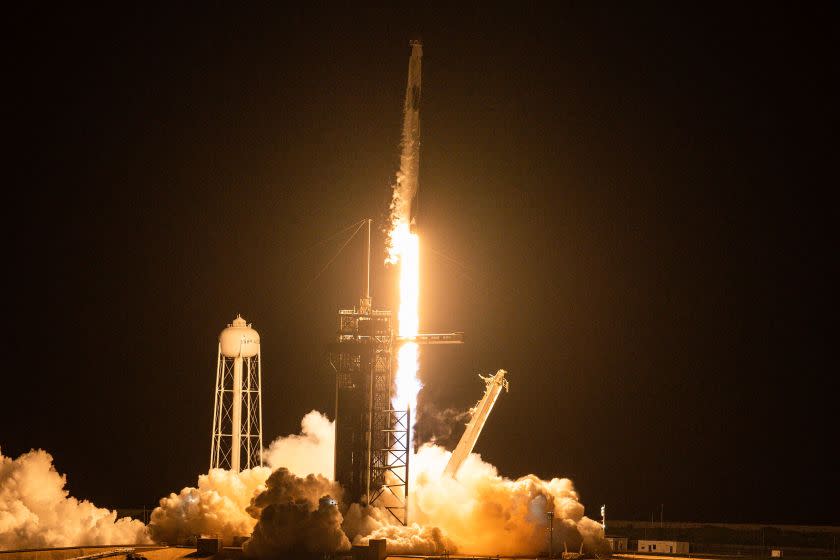SpaceX launches first all-commercial crew of astronauts: "It's pretty incredible"

A billionaire, a physician assistant, a geoscience professor and an engineer rocketed to space aboard a SpaceX capsule in the latest milestone for the commercial space industry — the first time an entire crew of people who aren't professional astronauts reached orbit.
The mission, known as Inspiration4, lifted off Wednesday shortly after 5 p.m. Pacific time from NASA's Kennedy Space Center in Florida. The capsule separated from the second stage of the Falcon 9 rocket about 12 minutes after liftoff. The crew will be in orbit in SpaceX's Crew Dragon capsule for three days at an altitude of about 357 miles above the Earth before splashing down off the coast of Florida.
The mission is unlike previous crewed launches to orbit. For one, it was the brainchild not of a national government but of billionaire tech entrepreneur Jared Isaacman, 38, who founded payment processing company Shift4 Payments. Isaacman bought out an entire SpaceX capsule for himself and three others for an undisclosed price and will serve as the mission's commander.
"Few have come before, and many are about to follow," he said on a livestream of the launch after the capsule reached space. "The door's opening now, and it's pretty incredible."
With the launch, Isaacman aimed to raise $200 million for St. Jude Children's Research Hospital. He committed to donating $100 million to the hospital himself and announced a sweepstakes in February in which people interested in going to space could donate money and be entered into a raffle to win one of the three remaining seats.
That seat ended up going to Chris Sembroski, a Lockheed Martin engineer who entered the sweepstakes, did not win but will be going to space anyway after a friend who won the seat transferred the prize to him, according to the New York Times. Sembroski is a mission specialist aboard the flight.
Another seat on the capsule was awarded to Sian Proctor, a longtime geoscience professor at South Mountain Community College in Phoenix who was a finalist in 2009 for NASA's astronaut program and is a trained pilot. Proctor won her seat in an online business competition run by e-commerce platform Shift4Shop, which is owned by Isaacman's company.
She is the capsule's pilot and is the first Black woman to pilot a spacecraft. A minute before launch, she made a thumbs-up sign at a camera inside the capsule, following it seconds later with a heart; about nine minutes after lift-off, after mission control called out that the capsule made a "nominal," or normal, orbit insertion, she gave another thumbs-up.
The fourth seat was given to Hayley Arceneaux, a physician assistant at St. Jude and a childhood cancer survivor who was treated at the hospital. Arceneaux is the flight's medical officer. At 29, she is the youngest American to go to space and the first to fly with a prosthetic body part — a portion of her femur is metal.
The crew trained for months before their mission, rehearsing contingency plans for emergencies, practicing in a simulator of the capsule and learning about the human health research they plan to conduct during their flight.
Wednesday's launch comes on the heels of a highly publicized summer of billionaires launching into suborbital space.
In July, British billionaire Richard Branson and a crew of five other Virgin Galactic employees reached the edge of space in Branson's company's space plane — the first time the craft had flown with a full crew aboard. Then, days later, Amazon.com founder Jeff Bezos flew to suborbital space with three others aboard his space company Blue Origin's rocket and capsule system.
Both companies plan to offer suborbital space rides to paying tourists, a business plan that each has asserted will open up space beyond the limited cadre of professional astronauts or the few wealthy private astronauts who have flown to the space station.
Critics say that the high cost of tickets — Virgin Galactic recently reopened its sales with seat prices starting at $450,000 — will limit space travel to the wealthy, and that the billionaires could have used their funds to support worthy causes closer to home.
Besides Isaacman, the crew on Wednesday's flight was a group of ordinary people who are not extremely wealthy, which could "excite a lot of people" who have their own dreams of spaceflight, said Alan Ladwig, author of the book "See You in Orbit? Our Dream of Spaceflight" and a former NASA official.
But other than through contests and sweepstakes, spaceflight for the average person will still be price-constrained, at least for now.
"There's going to be a handful of people that get to go, but in terms of everybody being able to fulfill their dream to fly — of the millions of people who have that dream — I think we’re some years away from that,” Ladwig said.
This story originally appeared in Los Angeles Times.

